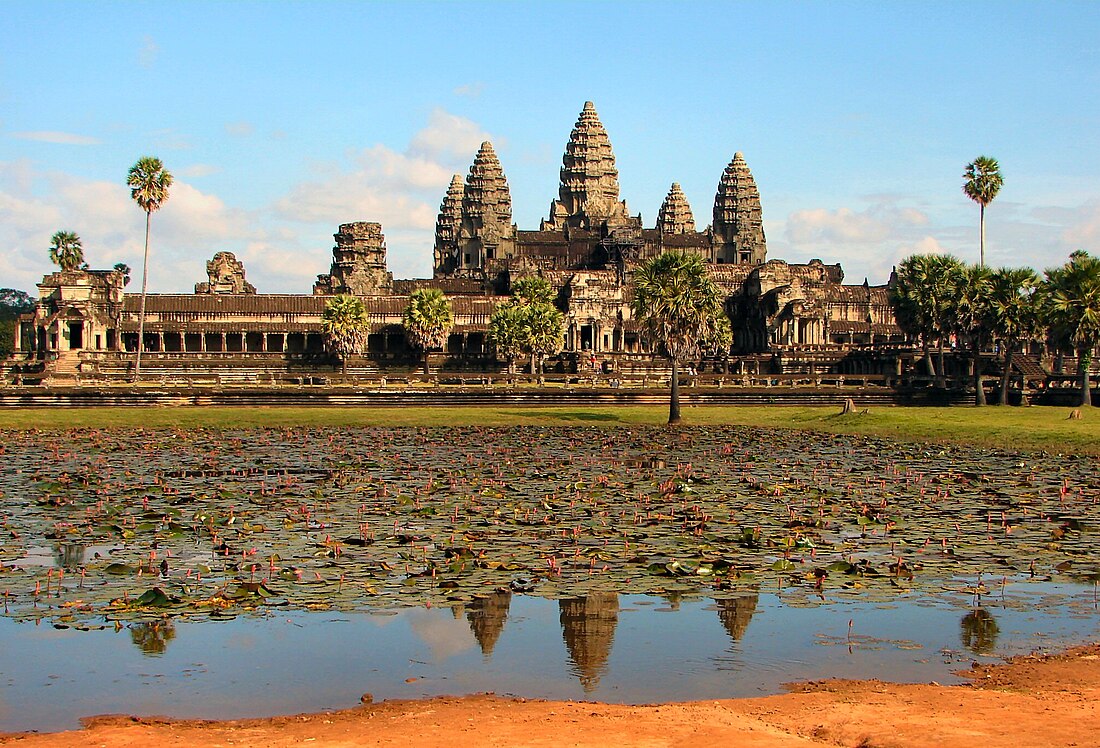അങ്കോർ
From Wikipedia, the free encyclopedia
Remove ads
9ആം നൂറ്റാണ്ട് മുതൽ 15ആം നൂറ്റാണ്ട് വരെ ഖമർ സാമ്രാജ്യത്തിന്റെ തലസ്ഥാനമായിരുന്ന കംബോഡിയയിലെ ഒരു സ്ഥലമാണ് അങ്കോർ({{lang-km|អង្គរ}[2][3] .1010-1220 കാലഘട്ടത്തിൽ ലോകത്തിലെ ജനസംഖ്യയുടെ 0.1% ആളുകൾ വസിച്ചിരുന്ന മഹാനഗരമായിരുന്നു അങ്കോർ.അങ്കോർ എന്ന വാക്ക് ,സംസ്കൃതത്തിലെ നഗര(नगर) എന്ന വാകിൽ നിന്നാണ് വന്ന്ത്.അതിനർഥം വിശുദ്ധ നഗരം എന്നാണ്[4]:350[5] .അങ്കോറിയൻ കാലഘട്ടം ആരംഭിക്കുന്നത് AD 802 മുതൽക്കാണ്.ഖെമർ ഹിന്ദു ഏകാധിപതി ജയവർമ്മൻ രണ്ടാമൻ സ്വയം താൻ പ്രപഞ്ച അധിപനാണെന്നും ദൈവ രാജാവാണെന്നും പ്രഖ്യാപിച്ചു.പതിനാലാം നൂറ്റാണ്ടിന്റെ അവസാനം 1351ലെ ആയുധായന്റെ അധിനിവേശം വരെ ഈ സാമ്രാജ്യം നില നിന്നു. ആയുധയന്റെ അങ്കോർ കൊള്ളയടിചതിന്റെ ഫലമായുണ്ടായ 1431ലെ ഖെമർ പ്രക്ഷോഭത്താൽ ജനങ്ങൾ തെക്കോട്ട് ലോങ്ങ്വേകിലേക്ക് പലായനം ചെയ്തു.
അങ്കോറിന്റെ അവശിഷ്ടങ്ങൾ കാടിന്റെ നടുവിലും ക്രഷി സ്ഥലത്തിലും വടക്ക് വലിയ തടാകത്തിന്റെയും(Great Lake) തെക്ക് കുലെൻ മലകളിലും സീം റീപ് പ്രവശ്യയിലെ സീം രീപ് നഗരത്തിലും ഇന്ന് കാണപ്പെടുന്നു.അങ്കോറിലെ ക്ഷേത്രം ആയിരക്കണക്കിന് സ്ഥലങ്ങളിലായി അവശിഷ്ടങ്ങളും മൺക്കട്ടകളും കൂട്ടിയിട്ടിരിക്കുന്നു.ലോകത്തിലെ ഏറ്റവും വലിയ ഒറ്റ മത സ്മാരകമായി ഇത് കണക്കാക്കുന്നു.അങ്കോറിലെ അനേകം ക്ഷേത്രങ്ങൾ പുനർ നിർമ്മിക്കുകയും പുനര്യോജിപ്പിക്കുകയും ചെയ്തിട്ടുണ്ട്.അവ ഖെമർ വാസ്തു ശൈലിയിലാണ് നിർമ്മിച്ചിരിക്കുന്നത്.വർഷത്തിൽ ഇരുപത് ലക്ഷം ആളുകൾ ഇന്ന് ഇവിടം സന്ദർശിക്കുന്നു.അങ്കോർ വാട്ടും(Angkor Wat) അങ്കോർ തോം(Angkor Thom) എന്നിവ യുനെസ്ക്കോ ലോകപൈതൃക കേന്ദ്രങ്ങളായി സംരക്ഷിച്ച് പോകുന്നു.ധാരാളം സന്ദർശക ആധിക്യത്തിൽ അവശിഷ്ടങ്ങൾ സംരക്ഷിക്കപ്പെടുന്നത്തിൽ പല പ്രശ്നങ്ങളും ഇന്ന് നേരിടുന്നു.


2007ൽ ഗവേഷകരായ അന്താരാഷ്ട്ര സംഘം സാറ്റ്ലൈറ്റ് ഫോട്ടോഗ്രാഫുകളുടെയും അത്യാധുനിക സാങ്കേതിക വിദ്യയുടെ സഹായത്താലും ഈ പ്രദേശം നിരിക്ഷിച്ചതിൽ നിന്ന് പ്രാചീന കാലത്തെ ഏറ്റവും വലിയ വ്യവസായ നഗരമായിരുന്നു ഇതെന്ന് വിലയിരുത്തി[6] .1000 കിലോമീറ്റർ വിസ്തീർണ്ണത്തിൽ കിടക്കുന്ന നാഗരികമായ ക്ഷേത്രം ഇതിൽ പ്രധാനമാണ്.അങ്കോറിനെ ഹൈഡ്രോളിക് സിറ്റിയായാണ് കരുതുന്നത്.കൃത്യമായ ജല വിതരണവും സംരക്ഷണവും ശാസ്ത്രീയമായി ഇവിടെ നടത്തിയിരിക്കുന്നു[7] .ഇവ കൃഷിക്ക് അനിയോജ്യമായതിനാൽ ജന വർദ്ധനവിന് കാരണമായി.അങ്കോറിന്റെ ജനസംഖ്യയുടെ കണക്കുകൾ തർക്ക വിഷയമാണ്.പുതിയ കാർഷിക സബ്രദായം അനുസരിച്ച് ഏകദേശം 10 ലക്ഷം ആളുകൾക്ക് മാത്രമേ ഇവിടെ താമസ്സിക്കുവാൻ സാധിക്കുകയുള്ളു[8] .
Remove ads
അവലംബം
- Audric, John (1972). Angkor and the Khmer Empire. London: R. Hale. ISBN 0-7091-2945-9.
- Chandler, David (1992). A History of Cambodia. Boulder: Westview Press.
- Coedès, George (1968). The Indianized States of Southeast Asia. Honolulu: East West Center Press.
- Coedès, George (1943). Pour mieux comprendre Angkor. Hanoi: Imprimerie d'Extrême Orient.
- Forbes, Andrew; Henley, David (2011). Angkor, Eighth Wonder of the World. Chiang Mai: Cognoscenti Books. ASIN: B0085RYW0O
- Freeman, Michael; Jacques, Claude (1999). Ancient Angkor. Trumbull, Conn.: Weatherhill. ISBN 0-8348-0426-3.
- Higham, Charles (2001). The Civilization of Angkor. Berkeley: University of California Press.
- Petrotchenko, Michel (2014). Focusing on the Angkor Temples: The Guidebook, 383 pages, Amarin Printing and Publishing, 3rd edition, ISBN 978 616 361 118 5
- Stern, Philippe (1934). "Le temple-montagne khmèr, le culte du linga et le Devaraja", Bulletin de l'École française d’Extrême-Orient 34, pp. 611–616.
- National Review: In Pol Pot Land: Ruins of varying types Sept 29, 2003.
- UNESCO: International Programme for the Preservation of Angkor Accessed 17 May 2005.
- "Climate change killed ancient city". The Australian. 2007-03-14. Archived from the original on 2007-03-24. Retrieved 2007-03-16.
- Smith, Justine (2007-02-25). "Tourist invasion threatens to ruin glories of Angkor". London: The Observer.
- Dayton, Leigh (2007-08-14). "Angkor engineered own end". The Australian. Archived from the original on 2007-09-10. Retrieved 2007-08-14.
- "Map reveals ancient urban sprawl". BBC News. 2007-08-14.
- Pescali, Piergiorgio (2010). Indocina. Bologna: Emil. ISBN 978-88-96026-42-7.
- Wagner, Jonathan (1992). "Environmental planning for a world heritage site: Case study of Angkor, Cambodia." Journal of Environmental Planning & Management Vol 38(3) pp. 419.
Remove ads
പുറത്തെക്കുള്ള കണ്ണികൾ
Wikiwand - on
Seamless Wikipedia browsing. On steroids.
Remove ads

